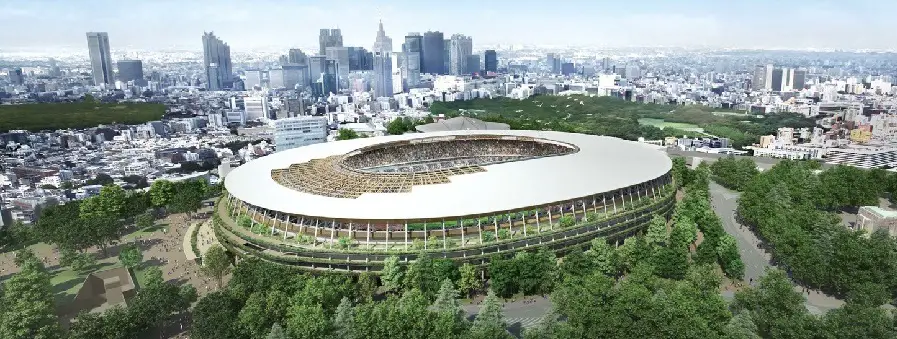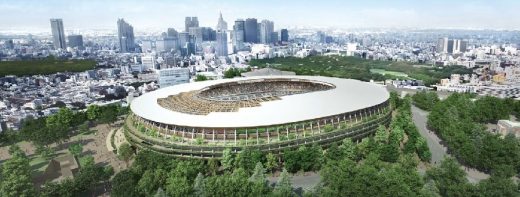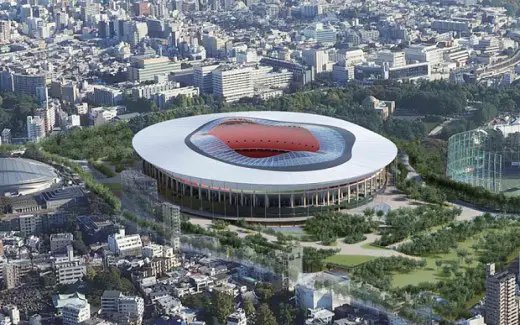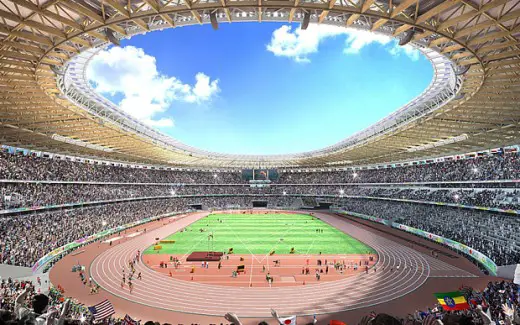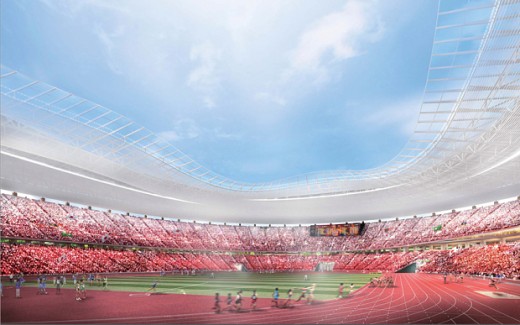Tokyo 2020 Olympic Stadium Building Design, Japanese arena material news, Tropical plywood in Japan construction:
Tokyo 2020 Olympic Stadium Building
Unsustainable Sports Arena Building Japan? project design by Kengo Kuma and by Toyo Ito Architects.
Tokyo 2020 Olympic Stadium Inauguration Overshadowed by Legacy of Rainforest Destruction
~ SDGs Undermined; NGOs Demand Accountability from Tokyo 2020 Organizers ~
To mark the inauguration of the New National Olympic Stadium in Tokyo on December 21st, 12 NGOs issued the following statement, denouncing the Stadium’s severe negative impact on the tropical rainforests in Indonesia and Malaysia as a result of its construction:
Tokyo 2020 Olympic Stadium building design by Kengo Kuma and by Toyo Ito, Architects:
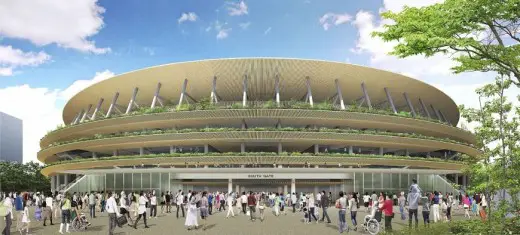
image courtesy of architects
27 Dec 2019
Tokyo 2020 Olympic Stadium Design
“The construction of the New National Olympic Stadium in Tokyo has come at an enormous cost to the Southeast Asian tropical rainforests. The substantial use of tropical plywood from Indonesia and Malaysia has led to the degradation and permanent loss of valuable rainforests, at the expense of the climate, biodiversity, and the rights and livelihoods of Indigenous Peoples and local communities. In the midst of today’s celebrations, it is important to remember the unnecessary harm the stadium construction has caused.
While Tokyo 2020 organizers committed to help implement the Sustainable Development Goals (SDGs), Tokyo 2020’s extensive exploitation of rainforests has in fact undermined achievement of the SDGs, particularly SDG Target 15.2 which aims to halt deforestation and restore degraded forests by 2020, as well as Target 15.5 which aims to halt the loss of biodiversity and, by 2020, protect and prevent the extinction of threatened species.
New National Stadium Tokyo design by Kengo Kuma & Associates:
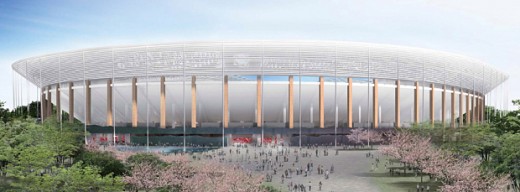
Disclosures by Tokyo 2020 organizers reveal that tropical plywood from Malaysia and Indonesia, equivalent to up to 6,902m3 in logs (RWE), were used to build the Stadium’s concrete foundation and other structures. This plywood is typically used several times to mold concrete and then disposed of, a process which has been widely criticized as wasteful and unsustainable. Given the significance of tropical forests as the habitat for the majority of terrestrial biodiversity, and given their critical importance as a carbon sink and home to Indigenous Peoples, it is clear that Tokyo 2020 Olympics’ disposable use of tropical wood contradicts Japan’s commitment to host a sustainable Olympic Games.
A closer look at the timber suppliers for the Stadium reveals that some if not all of the wood from Indonesia was supplied by a notorious company in Indonesia called Korindo that has been embroiled in tropical deforestation, land grabbing, illegal acts and tax evasion. An investigation into Korindo’s Olympic-related plywood supply chain revealed that nearly 40% of the plywood manufactured in 2017 derived from the permanent conversion of rainforests into coal mines or plantations such as palm oil – this included the destruction of critically endangered Bornean Orangutan habitat. Korindo was also found to have violated community land rights and cleared around 30,000 ha of natural forest for oil palm expansion since 2013, including High Conservation Value (HCV) areas. These findings were recently confirmed by the Forest Stewardship Council (FSC). The Stadium’s use of Korindo wood is clear evidence of Tokyo 2020’s connection to these Indonesian forest crimes.
The Stadium has also used substantial wood from Sarawak, Malaysia, which has a long history of illegal logging, corruption, and land rights violations. Wood found at the Stadium were supplied by logging company Shin Yang, which has been repeatedly linked to tropical forest destruction and human rights abuses. The plywood mill that supplied the Shin Yang wood to the Stadium has been criticized of anti-union discrimination, and the company has previously been implicated in logging in the Heart of Borneo, which is said to be home to 6% of global biodiversity.
NGOs have sought accountability from Olympic organizers for the Stadium’s links to rainforest destruction and human rights abuses. However, the entity responsible for the Stadium, the Japan Sport Council (JSC), has thus far taken no responsibility for the harms committed through its sourcing practices. In November 2018, RAN and others filed two grievances with the JSC concerning the 1) use of conversion timber including destruction of Orangutan habitat, and 2) use of Korindo wood linked to land rights violations. One year later, the JSC’s Grievance Mechanism has yet to accept the complaints that have been filed, stating they are still considering whether or not to accept the complaints. This has shown that the grievance mechanism is not working.
Tokyo 2020 organizers and sponsors must be held accountable for this unfortunate legacy of the New National Stadium, and they must ensure that no more tropical forests are sacrificed for the Olympics again. As a first step, Tokyo 2020 organizers should formally recognize violations of its own sustainability policies and the resulting negative impacts, and cooperate in providing remedy through its grievance mechanism. Tokyo 2020 should also clarify its recently updated timber procurement policy, such that all conversion timber, including timber derived from coal mining, is deemed unsustainable.”
Endorsed by:
Rainforest Action Network (US)
Bruno Manser Fund (Switzerland)
Sarawak Dayak Iban Association (Malaysia)
FoE Japan (Japan)
Environmental Investigation Agency (US)
Transformasi untuk Keadilan Indonesia/TuK INDONESIA (Indonesia)
Mighty Earth (US)
Global Environmental Forum (Japan)
Hutang Group (Japan)
Sarawak Campaign Committee (Japan)
Bob Brown Foundation (Australia)
Japan Tropical Forest Action Network (Japan)
Previously on e-architect:
New National Stadium Tokyo Designs
New National Stadium Tokyo Designs
New National Stadium of Japan in Tokyo
20 May 2017
Plywood at site of new Tokyo Olympic Stadium
Design: Kengo Kuma & Associates
Urgent investigation required:
Tropical Forest Timber at New National Stadium Tokyo
17 + 16 Jan 2016
Tokyo Olympic Stadium Architect Denies Plagiarising Zaha Hadid
Kengo Kuma defends his design:
Tokyo 2020 Olympic stadium architect Kengo Kuma rejects accusations that he stole the design from Zaha Hadid.
For reference: New National Stadium Tokyo Design by Zaha Hadid Architects, published September 18, 2015 ; updated on November 4, 2015 – selection of images below :
Reference: Fumihiko Maki: Architect, “Why Tokyo’s Olympic Stadium Should be Scrapped”, published on 4 Feb 2014:
Film on YouTube
Design Proposals for New Olympic Stadium in Tokyo
Japanese architects Kengo Kuma and Toyo Ito have unveiled rival proposals to build the 2020 Tokyo Olympic stadium, replacing Zaha Hadid’s competition-winning design.
The Japan Sport Council (JSC) has revealed images of the two designs competing for the Tokyo National Stadium contract, which are by Japanese architects Kuma and Ito.
Design A by architect Toyo Ito:
Design B by architect Kengo Kuma & Associates:
New Tokyo National Stadium – competition entry design by Andrea Maffei Architects
New National Stadium in Tokyo video presentation from Zaha Hadid Architects on Vimeo
Zaha Hadid Architects have not been able to secure a construction company in its consortium and therefore announce that they are unable to enter the competition.”
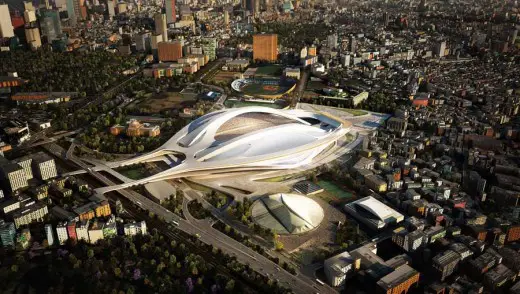
image © Courtesy of Zaha Hadid Architects
Zaha Hadid Architects: “It is disappointing that the two years of work and investment in the existing design for a new National Stadium for Japan cannot be further developed to meet the new brief through the new design competition.
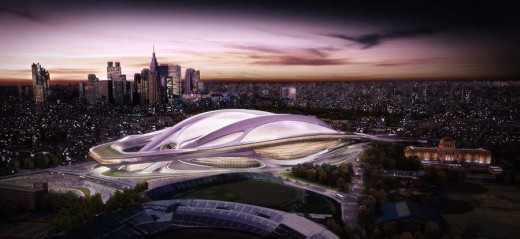
image © Courtesy of Zaha Hadid Architects
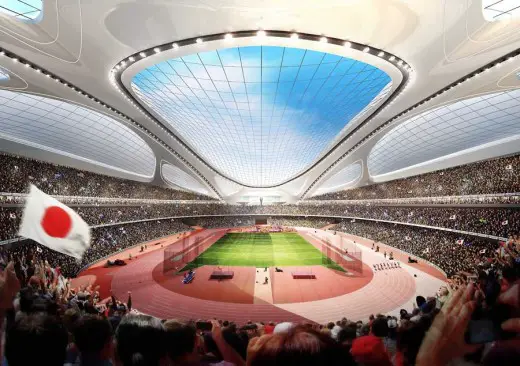
image © Courtesy of Zaha Hadid Architects
Kasumigaoka National Stadium Tokyo information received from ZHA
Kasumigaoka National Stadium Tokyo by ZHA – 27 May 2014
Location: Kasumigaoka National Stadium, Tokyo, Japan
Tokyo Architecture
Tokyo Architecture Selection
Tokyo Architecture Designs – chronological list
Architecture in Japan
Japanese Architect Offices
Tokyo Building Designs – Selection
Mode Gakuen Cocoon Tower
Design: Tange Associates Architects
Mode Gakuen Cocoon Tower
Ginza Natsuno R Building
Design: TNA Architects
Ginza Natsuno R Building
Alexandre Herchcovitch
Design: Studio Arthur Casas Architects
Alexandre Herchcovitch Tokyo Store
R·torso·C Residence
Architects: Atelier TEKUTO
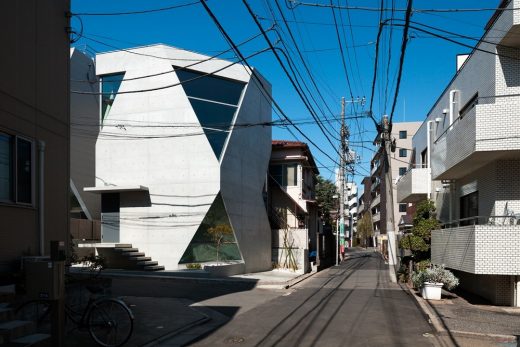
photos: Jérémie Souteyrat?SOBAJIMA, Toshihiro
R·torso·C Residence in Tokyo
Hopscotch House, Kita-ku, Saitama-shi, Saitama, Saitama Prefecture, Kanto region
Architects: Hideyuki Hiramoto (Hiramoto Design Studio)
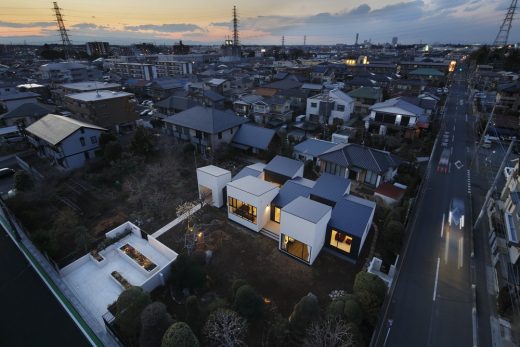
photograph : Koji Fujii (Nacása&Partners Inc.)
New House in Saitama
Xi’an International Football Centre, Xi’an
Design: Zaha Hadid Architects
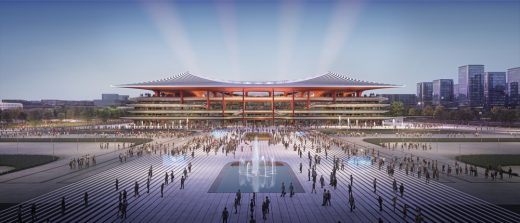
render by Atchain
Xi’an International Football Centre
Comments / photos for the Tokyo 2020 Olympic Stadium Building by Architects Kengo Kuma and Toyo Ito page welcome

